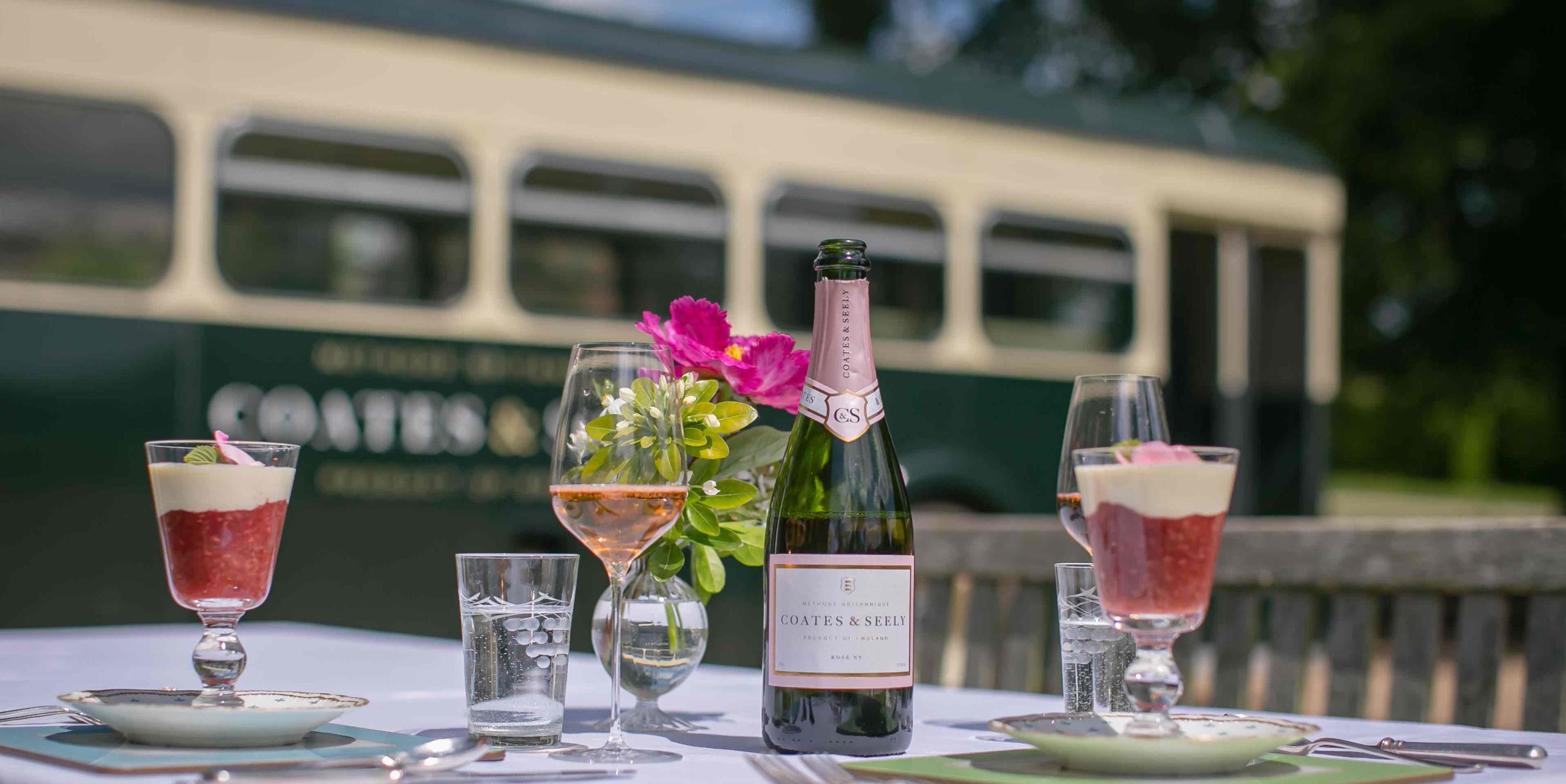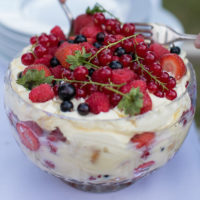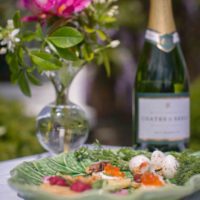English Sparkling Wine made in Hampshire
Having spent the last decade dedicating our energies to making the best English Sparkling Wine we can, using all the viticultural expertise and craftmanship available to us, we want to share a little of what drives us, how our wine-making year runs and a bit about how English Sparkling Wine is made and enjoyed.
Hampshire Vineyard
Nicholas Coates and Christian Seely took over their Hampshire Vineyard near Whitchurch in 2008. There had been a small vineyard in this location, serving the local community for decades. After extensive new planting and the introduction of expert French winemaking craftsmanship they produced their first wine, the Blanc de Blanc 2009 Vintage ‘La Perfide’. ‘La Perfide’ went on to win numerous awards and gold medals culminating in the 2019 International Wine & Spirit Competition Trophy for the best Bottle Fermented Sparkling Wine.
Since then Coates & Seely have gone on to produce some of the best English Sparkling Wine selected by the sommeliers from some of the greatest restaurants in the world.

The Grape Harvest
One of the most exciting times of a winemaker’s life is the Harvest. The decision on when to harvest is critical, bearing in mind all the variables.
We pick relatively late at Coates & Seely because we want the grapes to be fully ripe. Capturing the optimum balance of ripeness and acidity in the grapes whilst looking out for botrytis, a fungus that can harm the grapes, as well as fruit-loving songbirds, is a skill borne of long experience.
Added to the assessment of the grapes’ readiness is judging the weather and holding your nerve when you see that a frost might be coming or other vineyards in Kent and West Sussex have already started picking but you know that your own grapes aren’t quite ready.
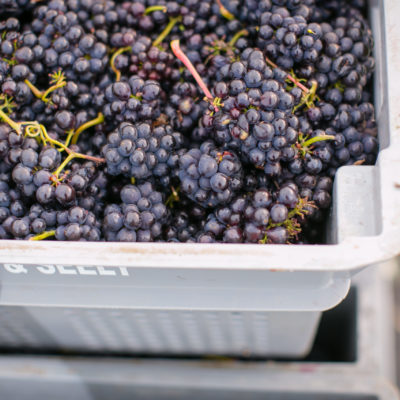
Picking the Grapes
Coates & Seely use both local volunteers and agency pickers for a period of two weeks to pick our grapes by hand.
The quality of the grapes each year will determine how many bottles of English Sparkling Wine are made and whether or not we will make a specific vintage wine for that particular year.
The Coates & Seely winery is at the heart of the vineyard, so our grapes go from vine to bottle within one square mile, ready for dispatch to our clients around the world.

English Sparkling Wine Production

At Coates & Seely we use the traditional method, our own version of the méthode champenoise – the Méthode Britannique – in our sparkling wine production.
First Fermentation
Once the wine grapes are harvested and pressed, they undergo their First Fermentation. Coates & Seely are unique amongst English Sparkling Winemakers in making use not only of stainless steel tanks but also of concrete fermentation eggs. The use of the egg shape is relatively novel and allows better convection of the wine while it ferments, giving greater depth and complexity to the flavour.
The quality and size of each year’s harvest will determine which wines are made that year and Coates & Seely’s expert winemakers will blend the optimal combination of the grape varieties for each sparkling wine. Whether this is White or Rosé, Vintage or Non-Vintage sparkling wine.
The Second Fermentation
The wine is bottled after several months in the eggs and tanks and undergoes its second fermentation in the bottle. This is where the carbon dioxide is released in the bottle, creating the fizz. It is important that the bubbles are small and persistent, creating a smooth and sophisticated ‘mousse’.
Wine Ageing
The wine is aged in the bottle depending on the style of wine being made. Our vintage sparkling wines are typically kept ‘on lees’ for five years. We typically keep our non-vintage sparkling wine for two and a half to three years before disgorgement.
The term ‘lees’ refers to the sediment formed in the bottle. The sediment is from the leftover broken down yeast after the sugars are consumed during the fermentation process.
Riddling
Riddling is a key part of the age-old method of separating the sediment from the wine. The process involves gradually rotating the bottles while tilting them neck down. The sediment flows to the neck of the bottle.
In traditional Champagne-making, riddling would be painstakingly carried out by hand. Nowadays we have ‘Gyropalette’ machines which can do the same job in a fraction of the time.
Disgorgement
After their time on lees, the wine disgorgement process takes place. The necks of the bottles containing the sediment are frozen and the increased pressure forces out the sediment.
A ‘dosage’ of sugar is added at this point. At Coates & Seely over the past few years our typical dosage levels have varied between 4 and 6 grams per litre.
The dosage used can vary significantly between different sparkling wine varieties in different countries, each having a slightly different palate.
The bottles are then corked and laid down for further bottle ageing.

Ingredients in English sparkling winemaking
Sparkling winemaking is an ancient production technique. Our fine English Sparkling Wine is made very simply from the juice pressed from the Chardonnay, Pinot Noir and Pinot Meunier grapes, the only additions to the grape juice are the yeast to aid fermentation, the dosage of sugar and a minimal amount of fining agent to help the clarity of our wines.
At Coates & Seely we no longer use isinglass and have moved to a vegan fining agent, so our English Sparkling Wines are now proudly vegan.
We use very few sprays on our vineyards at Coates & Seely, we never use herbicide, we never use insecticide, but we do, sparingly, use fungicides.
Fungicides are designed to keep the mildews such as botrytis, at bay. Botrytis can attack our vines in particular in the approach to harvest time. They dry out the infected grapes which then fall off leaving the rest of the bunch healthy and ready for picking. And ready for making into great sparkling wine.
Terroir
The reason Hampshire vineyards such as Coates & Seely produce such high quality grapes for the production of sparkling wine is the ‘terroir’ or land on which the vines are grown. The terroir closely reflects the climate, soil and topography of the Champagne region of France.
Hampshire Sparkling Wine
Hampshire have several award winning vineyards around Winchester and the South Downs where the chalky slopes are perfect for growing grapes used in sparkling wine-making.
The chalk subsoil under our Hampshire vineyard provides good drainage but also stores water, so the vines are encouraged to develop deep roots. Drought is not a concern for winemakers on this soil. The chalk imparts a mineral flavour also present in French Champagnes.
The chalk found under the slopes of Hampshire and the North and South Downs extends under the Channel and is similar to that found under many of the various districts of the Champagne region of France. Formed before the last ice age the chalk was laid down in the Late Cretaceous period when Britain was still connected to Continental Europe.
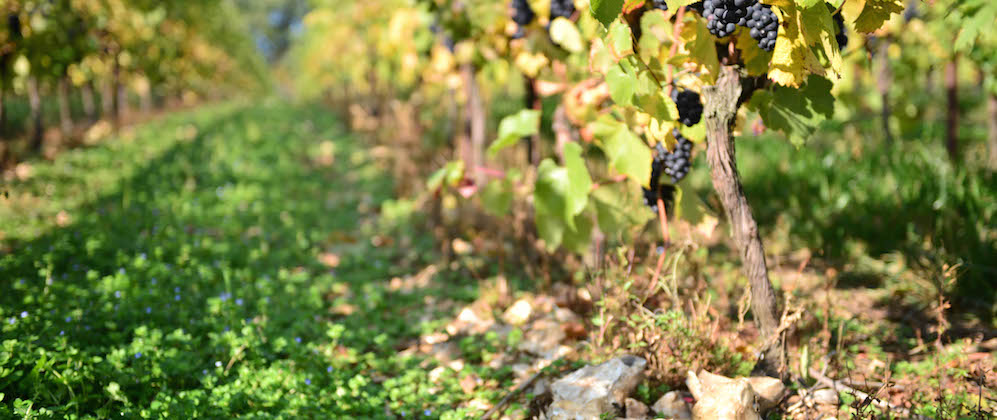
The Vineyard Landscape
Ideally, the vines for sparkling wines are grown on the slopes of a south-facing hillside which provides optimum drainage but most importantly the ideal exposure to sunlight. Whilst in Champagne the optimum planting range can be between 200 to 250 metres above sea level, in Southern England the optimal height is more likely to be between 80 to 120 metres above sea level.
The yield of sparkling wine per hectare on our wine estate is considerably less than a typical champagne vineyard due largely to the somewhat different prevailing weather conditions. However, Coates & Seely’s pursuit of excellence drives us towards deliberately lower yields to achieve the ripeness we require for the perfect sparkling wines.
Climate for growing sparkling wine
The climate in Southern England, after the gradual increase in average temperatures over the last 20 years, now corresponds more closely with the temperatures to be found in the region of France known for Sparkling Wine production.
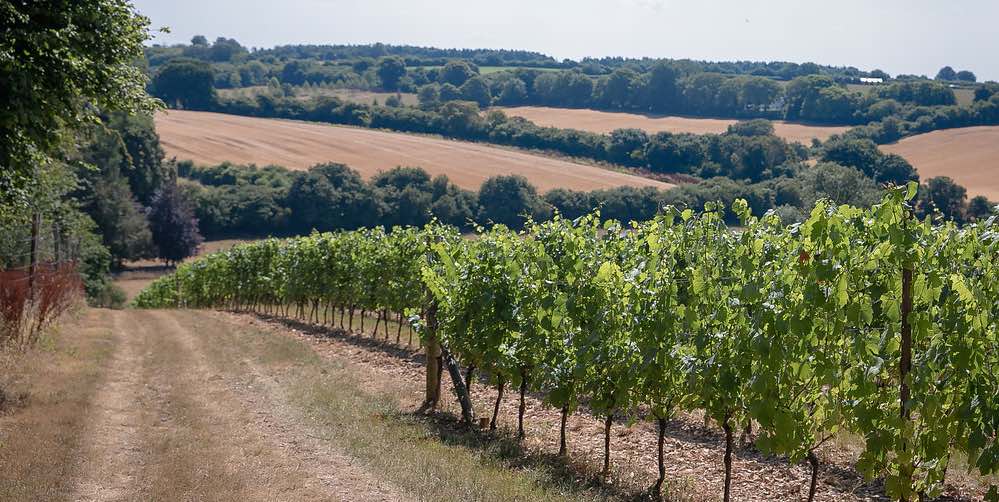
Grape Varieties
The planting of our Hampshire vineyard matches a traditional Champagne vineyard, with Chardonnay, Pinot Meunier and Pinot Noir vines. The varieties of grapes are blended differently for each of our wines.
Chardonnay
The well-known Chardonnay grape is a white variety and can be used in both still and sparkling wine production. Chardonnay gives a floral, citrus delicacy and imparts a creaminess to the wine.
Pinot Noir
The Pinot Noir is a distinctively dark black grape. It gives a depth and complexity to the wine and is very reflective of the terroir and production technique used in the wine-making. It grows especially well in the chalk subsoil of our terroir.
Pinot Meunier
Like the Pinot Noir, Meunier is a black grape. Pinot Meunier helps give the sparkling wine its fruit flavours and is typically the first of the grapes to be harvested. It is generally more tolerant of the slightly cooler climate and is also, beneficially, generally less susceptible to disease.
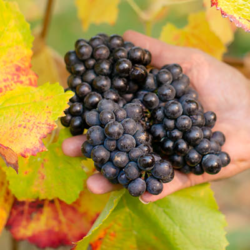


English Sparkling Wine Cuvées
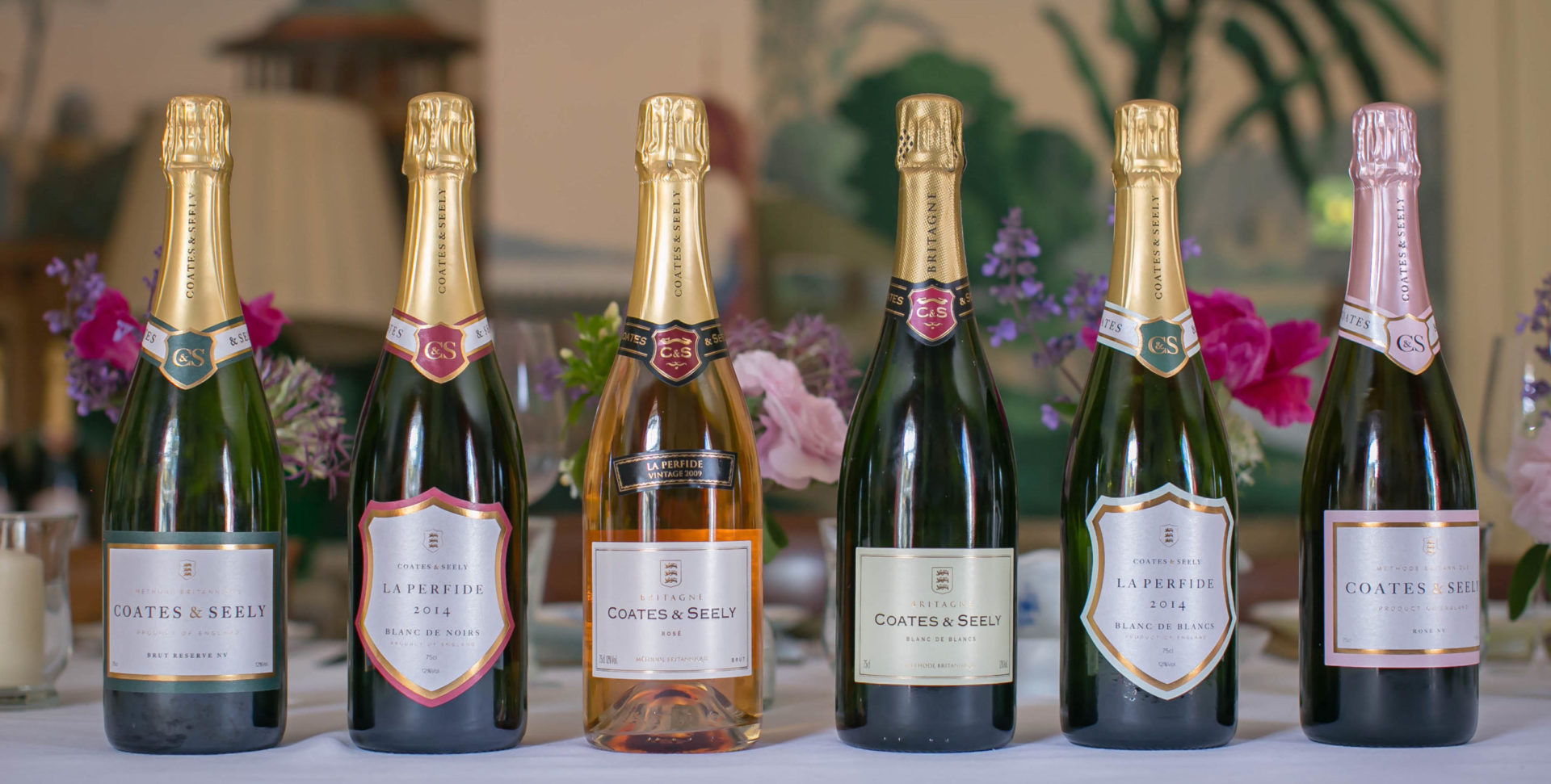
Vintage wines
A vintage wine is one made from grapes from a single harvest. At Coates & Seely we only make a vintage wine when the fruit is outstanding. In exceptional years we may choose to hold some of the best wine to release 5 or more years later as a vintage. Since we started making wine in 2009 we have had 4 vintage years for English Sparkling Wine.
In 2009 we produced our first wine, the multi-award and gold medal winning Blanc de Blanc 2009 Vintage ‘La Perfide’, made from 100% Chardonnay.
We also produced a vintage Rosé 2009 ‘La Perfide’ which won gold medals and trophies and was the highest scoring of all English Sparkling Wines in Robert Parker’s Wine Advocate in 2017.
In 2011 we produced our Brut Reserve 2011 ‘La Perfide’, a blend of Chardonnay and Pinot Noir and winner of Gold Medal and Trophy for Best Classic Cuvée at the UK Wine Awards (2018). Coates & Seely released their 2018 vintage ‘La Perfide’ in individually numbered magnums.
In 2014 we produced our first vintage Blanc de Noirs – Blanc de Noirs 2014 ‘La Perfide’ – which is released in 2021 and scored 94 points by Robert Parker’s The Wine Advocate. This is the highest score yet awarded to an English sparkling wine.
In 2018 we produced vintage Blanc de Blancs and Blanc de Noirs Sparkling Wines that are currently on lees.
Blanc de Blancs
This is white wine made from white grapes i.e. Chardonnay. The flavour of a Blanc de Blanc is generally more crisp and mineral. Our non-vintage Blanc de Blancs won Best Wine in Show and the Best English Sparkling Wine at the London International Trade Fair and the Best English Sparkling Wine at the IWSC Awards in 2016.
Blanc de Noirs
White wine from Black grapes i.e. Pinot Noir and Pinot Meunier. The Blanc de Noirs flavour is generally more rounded.
Rosé NV
The ever popular Rosé Non Vintage is made from Pinot Noir and Pinot Meunier grapes and has won Gold and Silver Medals in numerous international wine competitions.
Brut Reserve NV
Our non-vintage brut reserve is a white sparkling wine made from our Chardonnay, Pinot Noir and Pinot Meunier grapes. The Brut Reserve is a Gold Medal winner in the Champagne and Sparkling Wine World Championships.
Generally 75% to 85% of the grapes come from one year’s harvest with the remainder from reserve wines from previous years to give it more complexity and a little more consistency year on year.
Tasting Notes
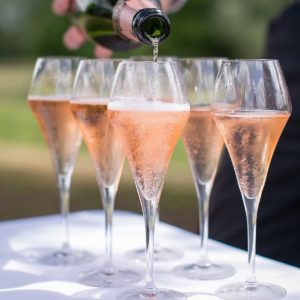
See the latest Tasting Notes and wine scores from Robert Parker’s Wine Advocate and James Suckling here.
The terminology used to describe wines can seem exaggerated, but when comparing different bottle-fermented sparkling wines, the differences in the key characteristics are noticeable.
The Colour of the wine
Colour can vary significantly from white, through pale yellows and golds to pale salmon or coral in a rosé. Colour may give an idea to the grape used, but red grapes aren’t only used for red wines.
Both Pinot Noir and Pinot Meunier are black grapes used in our sparkling white wines.
The Sparkle, or bubbles, in the wine
The size and flow, or stream, of the bubbles as they pour and appear in the glass is known as the ‘mousse’. It is best if the bubbles are small and persistent, giving rise to a mousse that is fine, creamy, pale and elegant.
For example the IWSC judges described C&S Blanc de Blanc La Perfide 2009 as having a “clean silvery stream of bubbles”.
The Aroma of the wine
The aroma of wine comes from the grapes used and the process of winemaking. The aroma can be talked of in terms of fruit flavours and floral notes. Examples include; rose petal, redcurrant, soft summer red fruits, peaches, blossom, apple, citrus or hazelnut.
Particular to sparkling wine is the ‘toast’ or ‘biscuit’ flavour it imparts, induced primarily by the autolytic process of the wine lying on its lees. It may seem a strange description, but a quick visit to the bottling room at Coates & Seely winery gives the most uplifting reassurance of this flavour.
While you may wish to swirl a still wine in the glass to release the aroma, a glass of sparkling wine should be treated more gently so as not to lose the sparkle.
The Characteristics of the wine
The characteristics of sparkling wine are harder to discern than through observing the colour or smelling the aroma. The collection of the taste sensations a wine gives can be variable giving layers of flavour and further description of the undertone and the finish.
The Coates & Seely expert winemakers will undertake to find the perfect balance of sweetness and acidity peculiar to the chalk soils of the region.

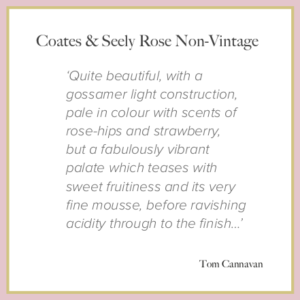

Food matching with English Sparkling Wine

Pairing Sparkling Wine with Local Hampshire Produce
When entertaining we like to pair our sparkling wines with seasonal, local ingredients sourced from the surrounding land: venison from the vineyards, organic vegetables from the next door farm, or fish from the River Test that flows along the valley floor.
A variety of canapés is ideal for showing off the depth of flavours in our wines, for example Carpaccio of Venison with Truffle Oil, Lymington hand-picked White Crab Croustades, Herbed Blinis with Chalk Stream Cold Smoked Trout with Horseradish & Dill, English Smoked Eel Purée on a seeded cracker, Tunworth Shortbread topped with Beetroot Hummus & Micro-cress, Soft boiled Quails Eggs served with smoked Maldon salt, Laverstoke Mozzarella with Isle of Wight Heritage Tomatoes & Basil or Slivers of Candied Beetroot with Pea & Lemon Verbena Purée.
This can be followed, depending on the season, by Poached Chalk Stream Fresh Trout, with Horseradish Cream, Heritage Tomatoes & Watercress in Summer or in Autumn a warming Roast fillet of Venison with Spiced Plums; Celeriac, Parsnip & Potato Gratin; Red Cabbage braised with Apples & English Cavalo Nero.
And to finish a pudding of English berries, such as Summer Pudding and a platter of mouthwatering local English cheeses.
The best foods bring out the best in the wines. Our sparkling wines shouldn’t be reserved just for celebrations. They can be served throughout the meal because the sparkling wines match the foods so well.
Our white Sparkling Brut Reserve works incredibly well with fish because the acidity of the wine breaks through the oiliness of the fish and the Rosé sparkling wine works wonderfully with Venison, somehow the earthiness of the venison with English Truffle Oil just bring out the fruits of the Rose and is a marvellous match.
The Perfect English Picnic
For a picnic we might offer Beef and Smoked Salmon, which are so British, are also a natural pairing with our wines. And we love to make Quail Scotch Eggs to serve at picnics.
Chicken Liver Paté works perfectly with the Rosé, the earthiness of the paté, matches well the sweet fruit of the fizz.
And of course what more perfect accompaniment to an English cream tea, an essential English experience, served with home-made strawberry jam, than a glass of sparkling Coates & Seely.
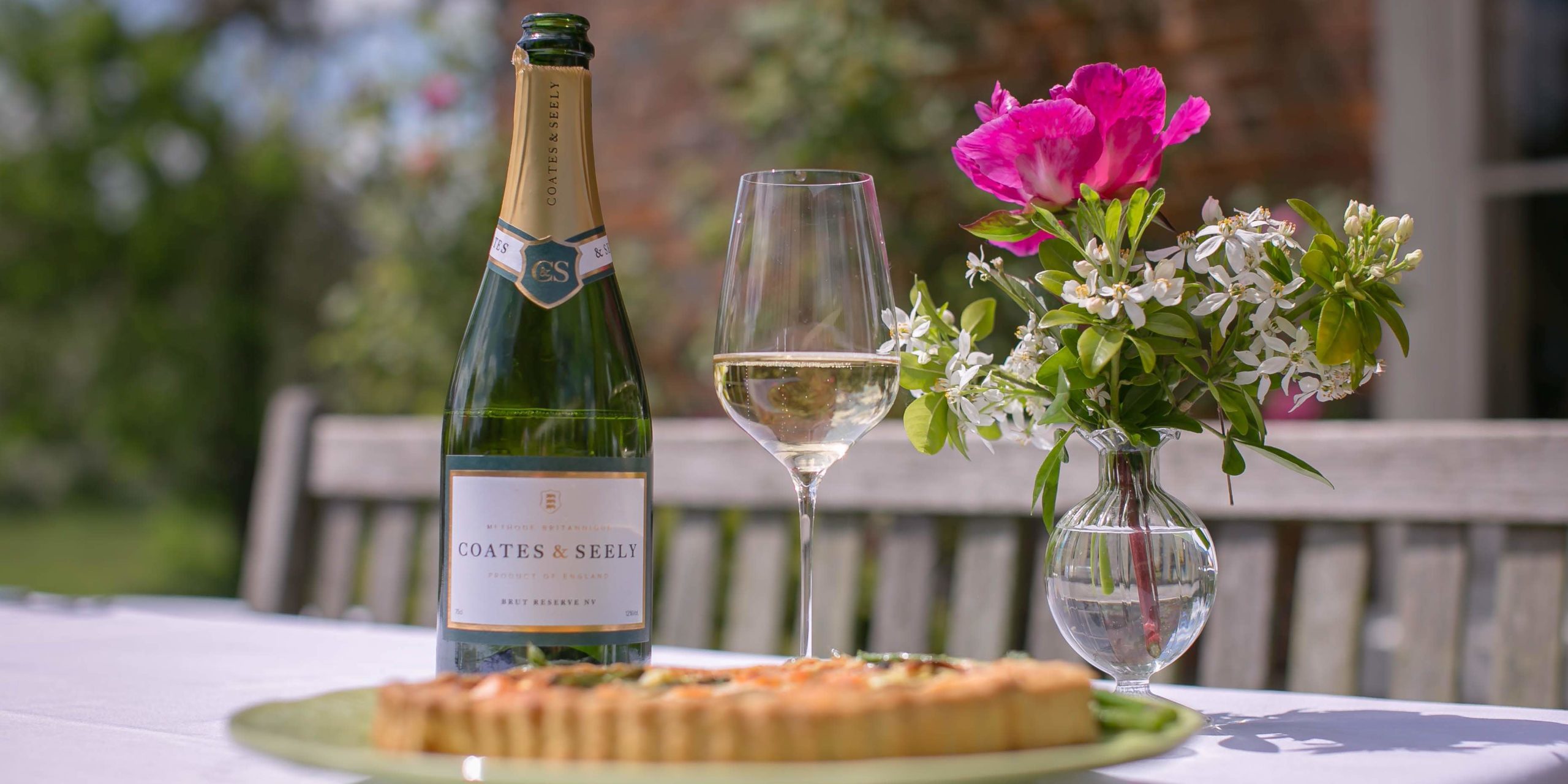
How to serve the perfect glass of sparkling wine
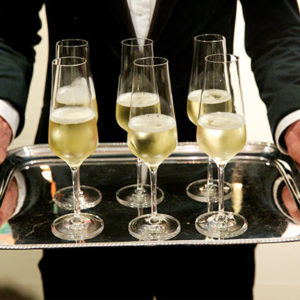
What is the ideal temperature for sparkling wine?
The ideal temperature for serving sparkling wine is between 8 and 12 degrees centigrade. An ice bucket is probably necessary for keeping your bottle cool when enjoying your fizz outside.
Which glass is best for sparkling wine?
The champagne flute or ideally a tulip remain the preferred glass for serving a sparkling wine. Whilst the coupe or saucer evoke a bygone glamour, the bubbles and aroma will disappear too quickly. The tulip arguably provides a better experience of the aroma.
Fill the glass just over half full so that the aroma remains in the neck of the glass.
Magnum or Bottle?
The usual bottle size for champagne and sparkling wine is 75 centilitres, however, a magnum, the equivalent of two bottles holds one and a half litres. Fantastic for larger celebrations and get-togethers, the magnum of sparkling wine is very striking.
How long can you keep English Sparkling Wine?
At Coates & Seely we age our non-vintage wines for up to three years, giving them great longevity (5 to 10 years). Non-vintage sparkling wines will last for less time than vintage wines.
Our vintage sparkling wines are kept on lees for up to 5 years or more and can be expected to last for 10 to 20 years.
A Very English Secret
At Coates & Seely our philosophy on winemaking has always been to produce a terroir wine which is an ultimate expression of the chalky slopes where our vineyard is located in Hampshire.
Even within our own vineyard there are individual parcels of vines that have individual personalities and that means working with great attention to detail on a small scale and to make wines that are authentic to a particular place.
Some of the main characteristics of Coates & Seely and English Sparkling Wine more generally is to do with how close the wine is to the fruit, for that reason you’ll find a lot of aroma of green apples particularly in our Brut sparkling wine and you can really tell that this wine is produced from a grape grown in Hampshire.
Coates and Seely remain relatively small in comparison to some of our competitors. Our focus has always been on quality above all other considerations. We are trying to produce the best sparkling wines in England, we are not the biggest and we don’t aspire to be. But we never compromise on the quality of our sparkling wines.
We only produce a limited amount of wine each year and what we want is for our English Sparkling Wines to be drunk in the most iconic hotels, restaurants and houses and for Coates & Seely to be really appreciated as an exclusive, luxury British wine producer.
Fundamentally we are a family firm, we are Coates and Seely and everything we do is driven by that ethic of being authentic and completely true to ourselves. This is true of the authenticity of the individual wines and how we make them, but also how we run the business.
